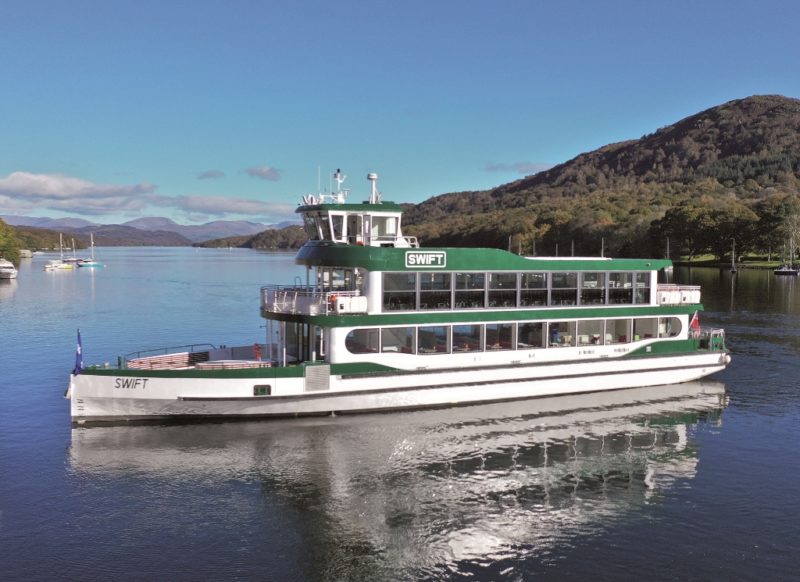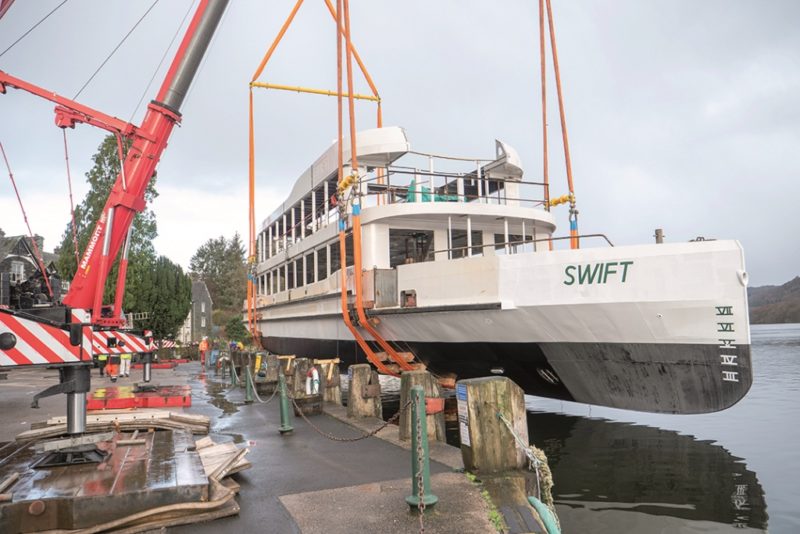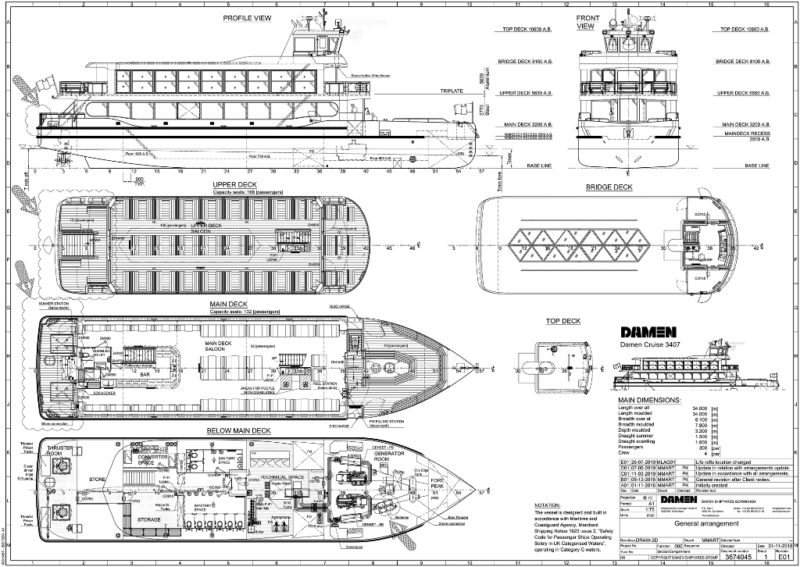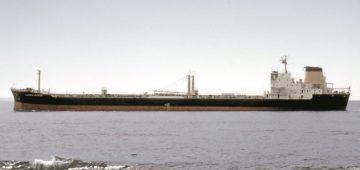 Windermere, England’s largest natural lake, is 10.5 miles (16.8m) long, 1 mile (1.6km) wide at its widest point and has a maximum depth of 200ft (61m). The lake forms part of The Lake District, which is a 912 square mile (2,362km2) region and national park in Cumbria in northwest England. The largest lakes total 16, ranging from Windermere (the largest) to Brotherswater. Lake Windermere is subject to a public right of navigation and in centuries past supported commercial traffic associated with slate and copper mining, timber, wool and fishing. In the early part of the 19th century a sailing packet service operated between Ambleside, Bowness, the Hawkshead Ferry and Newby Bridge. This service connected with the Ulverston to Lancaster Stagecoach at the Swan Hotel at Newby Bridge, and with the Lancaster to Whitehaven Stagecoach at Ambleside.
Windermere, England’s largest natural lake, is 10.5 miles (16.8m) long, 1 mile (1.6km) wide at its widest point and has a maximum depth of 200ft (61m). The lake forms part of The Lake District, which is a 912 square mile (2,362km2) region and national park in Cumbria in northwest England. The largest lakes total 16, ranging from Windermere (the largest) to Brotherswater. Lake Windermere is subject to a public right of navigation and in centuries past supported commercial traffic associated with slate and copper mining, timber, wool and fishing. In the early part of the 19th century a sailing packet service operated between Ambleside, Bowness, the Hawkshead Ferry and Newby Bridge. This service connected with the Ulverston to Lancaster Stagecoach at the Swan Hotel at Newby Bridge, and with the Lancaster to Whitehaven Stagecoach at Ambleside.
The first Steamer service began in 1845 using the 200-passenger capacity Lady of the Lake and served until 1865. The second vessel was the 1856-built Lord of the Isles but she succumbed to fire in 1850. In 1847 a second company, the Windermere Iron Steamboat Company, was formed to run cruises in conjunction with the newly opened Kendal to Windermere Railway. In 1849 they launched the Steamer Firefly with a second, the Dragonfly, following in 1850. After competing with each other, the two companies joined forces as the Windermere United Yacht Company in 1858. The Furness Railway Company opened a railway from Lakeside on June 1st 1869. The Furness Railway entered into an agreement with the Windermere United Yacht Company to purchase Steamer shares and in 1872 the Railway Company took sole control. The Steamers continued in Furness Railway ownership until becoming part of the London Midland Scottish Railway (LMS) network in 1923. Vessels came and went and traffic on the lake continued to grow rapidly during the Victorian years. In 1890 the Furness Railway commissioned Forrest & Sons of Wyvenhoe, Essex, to design and build a new Steamer. Originally to be called Swallow, a last-minute change of heart resulted in the vessel being named Tern. Launched in June 1891 with a passenger capacity of 633, the Tern still sails in the fleet today as the flagship of the Windermere fleet. The 121gt and 44.20m (145ft) long vessel was steam powered when built but in 1956 she was converted to diesel power in the form of twin 6-cylinder Cummins diesel engines, two auxiliary generators and a bow thruster. With a crew of 4, the 10-knot vessel can carry 350 passengers nowadays. Ten years later, the Swift, the last of the coal fired Steamers, was commissioned. The largest vessel ever built for service on Windermere, she was launched in 1900, carried 781 passengers and was converted to diesel in 1956 when her boiler burst and British Rail (who took over the service with nationalisation in 1948) installed Glennifer diesel engines for the 1957 season. She was withdrawn in 1981 and scrapped 1998-99 after attempts to preserve her were unsuccessful.
In 1935 the LMS decided to update and improve the Windermere fleet and a new motor vessel, the Teal, was ordered from Vickers Armstrong, of Barrow-in-Furness, and launched at Lakeside on 4th July 1936. The 251gt vessel had capacity for 877 passengers (533 in the present day). The sections of the Teal were transported by rail to Lakeside and assembled. The Teal is 43.20m (142ft) long, has a speed of 10 knots, a crew of 7 and was powered by twin 6-cylinder Kelvin diesel engines and two auxiliary generators. The Teal had new Volvo D13 engines installed during winter 2019-2020. The newbuild was so popular that a sistership, the Swan, was ordered by the LMS, also from Vickers Armstrong. The 251gt/43.20m (142ft) long Swan made her maiden voyage on 24th June 1938 and her passenger capacity nowadays is also 533 plus 7 crewmembers. Power is provided by twin 6-cylinder Cummins diesel engines and two auxiliary generators. Both vessels operate under the Windermere Lake Cruises flag today and have received improvements and new engines in recent years.
 Passenger numbers increased dramatically in the years immediately after the Second World War and LMS operations, including the Windermere Steamer fleet, became part of the British Rail network in 1948 when the railway companies were nationalised. The branch railway line from Ulverston to Lakeside closed on 5th September 1965, leaving the Steamers without a direct mainline rail link. Fortunately, the line reopened from Haverthwaite to Lakeside as a preserved railway from May 5th 1973. In 1970 British Rail’s marine division was renamed Sealink and the Steamer operation was rebranded Sealink Windermere. In 1984 Sealink was privatised and passed into the ownership of Sea Containers who renamed it The Windermere Iron Steamboat Company, thus resurrecting a name from history. In May 1993 the company returned to private local ownership when the Bowness Bay Boating Company purchased it. Today the historic Steamers sail alongside elegant launches such as Miss Lakeland, Miss Cumbria and Queen of the Lake and, collectively, the company operates as Windermere Lake Cruises. Today the vast majority of passengers arrive by car or coach but the railway connection at Windermere remains, plus a portion of the footfall at Lakeside is thanks to the steam railway.
Passenger numbers increased dramatically in the years immediately after the Second World War and LMS operations, including the Windermere Steamer fleet, became part of the British Rail network in 1948 when the railway companies were nationalised. The branch railway line from Ulverston to Lakeside closed on 5th September 1965, leaving the Steamers without a direct mainline rail link. Fortunately, the line reopened from Haverthwaite to Lakeside as a preserved railway from May 5th 1973. In 1970 British Rail’s marine division was renamed Sealink and the Steamer operation was rebranded Sealink Windermere. In 1984 Sealink was privatised and passed into the ownership of Sea Containers who renamed it The Windermere Iron Steamboat Company, thus resurrecting a name from history. In May 1993 the company returned to private local ownership when the Bowness Bay Boating Company purchased it. Today the historic Steamers sail alongside elegant launches such as Miss Lakeland, Miss Cumbria and Queen of the Lake and, collectively, the company operates as Windermere Lake Cruises. Today the vast majority of passengers arrive by car or coach but the railway connection at Windermere remains, plus a portion of the footfall at Lakeside is thanks to the steam railway.
A Swift Decision
On 7th May 2019 Windermere Lake Cruises announced that it had signed a contract with Damen Group on 25th September 2018 for the construction of a multi-million-pound and 300 passenger capacity boat to add to its existing fleet. To be named MV Swift (II), the newbuild was of the Damen Cruise 3407 design with a length of 34.00m long, a beam of 8.10m and a scantling draught of 1.60m. The vessel went into service from the mid-2020, making her the largest craft to be launched onto Lake Windermere for more than 80 years. The Swift has been designed to operate in all seasons, 364 days a year and, like the existing Windermere Lake Cruises’ steamers Swan and Teal, the new fleet member boasts three decks but is slightly shorter in length to enable her to access smaller jetties to help support other businesses in the area such as hotels including Low Wood Bay Resort & Spa.
The first steel cutting took place on 9th April 2019 at Damen’s Kozle yard in Poland, with construction expected to take approximately 17 months. The 1,650m2 shipyard originally opened in the 1970s as Kozielska Stocznia Rzeczna, in an area known for inland shipbuilding. Undergoing a series of transitions in the 1990s, the yard became Stocznia Koźle Serwis in 1996. In October 2006, the yard entered the Damen Shipyards Group and became Damen Shipyards Kozle. Damen Group itself was established in 1927 in Hardinxveld-Giessendam in The Netherlands by brothers Jan and Marinus Damen. Damen Shipyards’ first facility at Hardinxveld is located just 10km from the present-day Damen Group headquarters in Gorinchem. In 1969 Jan Damen’s son, Kommer Damen, took over and introduced a revolutionary idea, the standardisation and series production of workboats, which has allowed the company to go from strength to strength since.

The sections of the Swift were transported by road to Lakeside via the Cuxhaven-Immingham Ro-Ro ferry. The size of the vessel meant that it was necessary to build the little ship, section by section, in the car park behind the railway station at Lakeside before wheeling her to the water’s edge and lowering her into the waters of Lake Windermere. The keel was laid on 22nd July 2019 and Damen Shipyards Group planned the vessel construction process in close consultation with local authorities and residents to minimise the impact on this protected and environmentally sensitive area, which is also a UNESCO World Heritage Site. The wheelhouse was also fabricated in Kozle and transported to Holland for fitting out prior to before being shipped onward to the Lake District in the same manner.
Personnel from Damen Technical Cooperation supervised the build process and, on 11th December, the Swift was lowered into the water (above). The wheelhouse was then added to complete her profile. The fitting out process continued at the quay at Lakeside but was also subject to disruption during the Covid-19 Lockdown March-June 2020. Much consideration was given to this ‘one-of-a-kind’ vessel to ensure that she not only blends with the classic lines of the existing fleet and heritage of her surroundings, but also stands out as being a technologically modern lake cruising vessel. The Swift offers four-star comfort seating capacity for 300 passengers, is fully accessible by wheelchair Users and the roof of the top deck can be open or closed, depending on the weather conditions. More than 1.6m passenger journeys are taken every year, making cruises on Lake Windermere one of the most popular attractions in the UK so it was essential that the newbuild complimented both the operation and her fleet mates.
21st Century Classic
To meet the all-weather requirements of a day cruise/sightseeing vessel newbuild, the Damen Cruise 3407 design, with its ability to combine the classic and modern in one finished product, was quite literally made for the job. So, let us have a look at the layout of the Swift. As mentioned above, she has three decks plus the Bridge Deck where the wheelhouse is located forward, overlooking the bow. From her base line, the vessel has a height of 10.60m to the top of the bridge. The lowest level is Below Main Deck and, located in the forward half of the hull, are the machinery spaces.
Behind the fore peak is the bow thruster compartment containing an electrically powered 25kW transverse tunnel thrust unit. The Generator Room is also in this area, containing the two 216ekW Volvo D9A, 4-stroke, 6-cylinder generators. Astern of this area is the Technical Space containing the boiler, fuel oil (10.7m3 capacity) and waste water tanks etc. The passenger toilet facilities can be found adjoining the Technical Space, in the rear half of this deck. Aft of here is a storage area to starboard, a Fire Fighting Locker and, on the port side, the Converter Space.
The electrical power produced in the Generator Room is fed into here and then to the Thruster Room housing twin 150kW/2,200rpm Hydromaster Series 3 L-Drive propulsion units in the stern. These are each fitted with a 900mm diameter open type fixed pitch propeller. There is also a diesel driven fire fighting bilge pump in the stern. Between the Thruster Room and Converter Space is a stores area. The propulsion package produces a cruising speed of 10 knots and the Swift is operated by a crew of 4. One level above is the Main Deck (3.2m above the base line) with a passenger seating capacity of 132 (92 in the Main Deck Saloon and 40 on the open deck in the bow). The saloon is laid out with fixed booth-style seating with tables for two, a disabled toilet and a large bar counter aft. The bright décor is punctuated by red seats. The forward bulkhead has sliding doors, with stairs to the lower front deck. The stairs are equipped with a stair lift for wheelchairs.
The Upper Deck (5.65m above the base line) is laid out with wooden bench seats (one row either side and one central row) and large sliding windows on both sides which slide down to railing level and make the top deck a fully open area. The central section of the ceiling here is also glass, creating a wonderfully light and airy deck whilst maintaining shelter from above. Stairs to the wheelhouse are situated forward on this deck. The overall seating capacity here is for 168 passengers. (12 passengers on the open stern deck, 135 passengers in the Upper Deck Saloon and 21 passengers on the forward open deck). After trials, Damen Shipyards Group and Winander Leisure Limited signed the Protocol of Delivery and Acceptance for the official handover of the MV Swift on 13th October 2020.
The impressive new passenger vessel entered service on Sunday 25th October between Lakeside, Bowness (above) and Ambleside. As was always the aim, she was an instant hit with her passengers. The maiden passenger voyage departed Lakeside at 10.15am with passengers being pleasantly taken by surprise at being among the first people to enjoy the milestone cruise while adhering to social distancing rules.







Comments
Sorry, comments are closed for this item